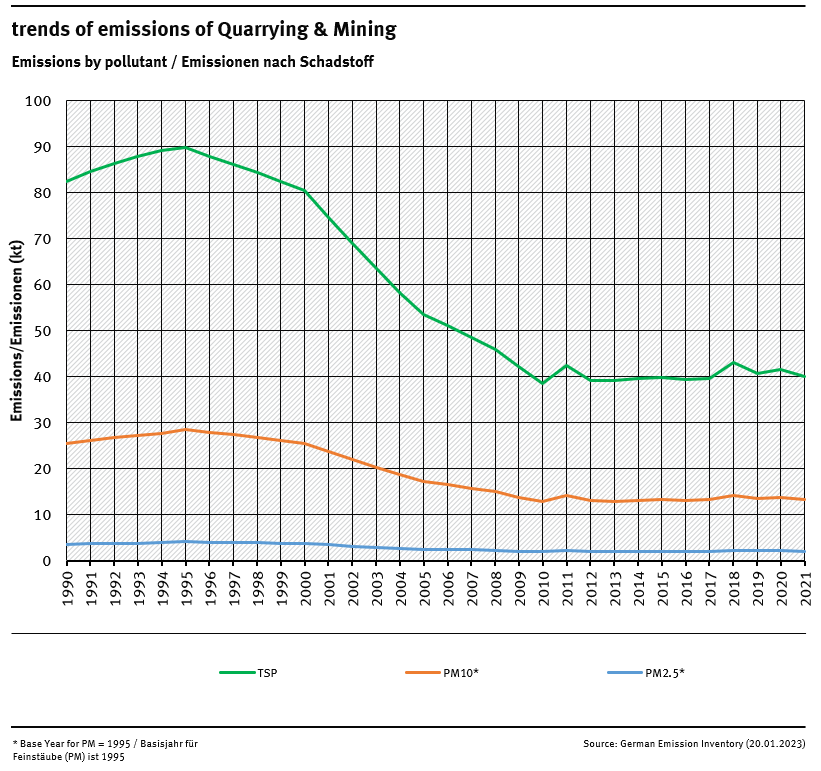meta data for this page
2.A.5.a - Quarrying & Mining - Other Than Coal
| Category Code | Method | AD | EF | ||||||||||||
|---|---|---|---|---|---|---|---|---|---|---|---|---|---|---|---|
| 2.A.5.a | T1 | IS | CS | ||||||||||||
| NOx | NMVOC | SO2 | NH3 | PM2.5 | PM10 | TSP | BC | CO | Pb | Cd | Hg | Diox | PAH | HCB | |
| Key Category: | - | - | - | - | L/- | L/T | L/- | - | - | - | - | - | - | - | - |
For particulate emissions, Mining is the main emissions source in the Mineral industries.
In Germany we use two approaches - one for Sands and rocks, one for salts.
Short description - Sands and Rocks
The mining process emits relevant amounts of particles. Quarrying and mining of minerals other than coal is subsumed, in particular mining of limestone, hard rock and building Sands, with rising recycled materials.
Methodology
With the use of the 2019 GB method 1), a Tier 2 method is available that can reflect different national conditions.
In particular, this concerns input variables on humidity and wind speed, which are differentiated into regions. Due to data availability, the regions are represented by the administrative states (German Länder), which does not necessarily represent characteristic weather regimes. Regionality can be increased by merging urban and surface states. Parameters on weather as well as on areas can thus be improved.
The temporal resolution of the regional parameters has limitations: no weather data reports are available on a station basis before 2010, so no area information from the Corine land cover before 2010 is used (consistent data sets). In addition, information from CLC category 131 (Mineral extraction sites 2)) had to be adjusted for areas of active open-pit lignite mines.
Activity Data
As provided in the Guidebook model, specific AD for hard rock, sand, and recycled material are applied. Because of incomplete national statistics, these AD are taken from association information 3). For time series concsistency, data gaps are closed via interpolation, resulting in higher AD.
Emission factors
The calculation of emissions takes into account national circumstances and reduction measures.The calculations are available in total more than ten Excel files (individual years since 1990, annually from 2010). Since the GB tool in principle calculates emissions for exactly one year 4), files must be available for exactly those years in which input data are available. Intermediate years are interpolated in case of data gaps.
With the help of the GB tools, IEFs are estimated on an annual basis, which are used for the inventory method AR x EF. The emission factors are virtual, but the calculation of this is modified by national circumstances on the parameters. So we would name the EF as country-specific.
Trend discussion
Recalculations
With activity data and emission factors remaining unrevised, no recalculations were carried out compared to Submission 2022.
Planned improvements
At the moment, it is planned evaluate further Country specific conditions.
Short description - Salt Production
Salt production is a sub-category of the mining activities in respect of the country specific approach used. Currently, a Tier 1 method is used: information on production of salts are multiplied with emission factors for TSP and PM.
Method
Activity data
The data from national statistics includes production of potash and rock salt. Potash salt is dominating, nevertheless gaps of statistics are filled and emissions are modelled as potash salt only.
Emission factors
The emission factors are based on analogy to bulk product handling by an UBA expert judgement:
Table 2: Overview of applied emission factors, in kg/t salt
| EF value | EF trend | ||||
|---|---|---|---|---|---|
| TSP | 0.031 | constant | |||
| PM10 | 0.016 | constant | |||
| PM2.5 | 0.003 | constant |
Recalculations
With activity data and emission factors remaining unrevised, no recalculations were carried out compared to Submission 2022.
Planned improvements
At the moment, no category-specific improvements are planned.


